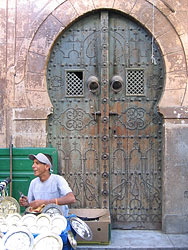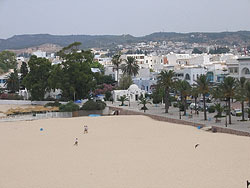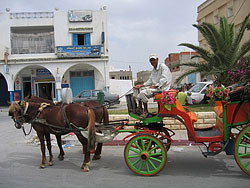A tale of the Maghreb
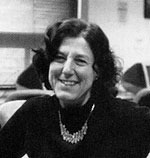
By Anne-Marie Gronhovd
Editor’s Note: This is the full version of Professor Gronhovd’s essay on the lands of Northwest Africa, which was published in a condensed version in the Summer 2007 Gustavus Quarterly.
One of the goals of the Department of Modern Languages, Literatures, and Cultures at Gustavus Adolphus College is to bring an international perspective to teaching, advising, and research. We engage our students and ourselves with the world by developing an appetite for a certain type of knowledge, one that opens the doors to other cultures, histories, and literatures. Experience on the spot is often the most practical way to convey this knowledge. Such was my experience during the summer of 2006 when I went to Tunisia with the intention of better understanding the Maghreb and engaging a longtime interest in the lands of Northwest Africa. Having received a Bush Foundation mini-grant in support of new research aimed at my teaching, I began a study of French colonization in North Africa and its repercussions on history, culture, and literature up to the present.
The Arabic term Djazirat el Maghreb means the Island of the Sunset or the Island of the Occident. The Maghreb encompasses Morocco, Algeria, and Tunisia. The original inhabitants of this region were the Berbers. But the Maghreb is conditioned by the Mediterranean coast, the Atlas mountain chains, vast deserts, and the fertility of the lands irrigated by its rivers. Over the centuries this geography attracted many invaders, among them the Arabs, who have stayed the longest and who have been the most influential, making the Maghreb an integral part of the Arab world. The French presence in Morocco, Algeria, and Tunisia began in 1830 and ended—in the case of Algeria—in 1962.
Starting my work at the Fourth International Conference on New Directions in the Humanities at the University of Carthage, in Carthage, Tunisia, I presented a paper titled “Algeria, a Land of Conflicts and Reconciliations. A literary approach to understanding Algeria, past and present. Hélène Cixous and Albert Camus.”
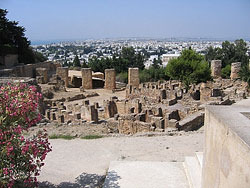
The ruins of the ancient city of Carthage are located on the eastern side of Lake Tunis, across from the center of modern Tunis, Tunisia’s capital city.
The conference, whose theme was “Global and Local Dialogues in the Humanities,” was aimed at engaging Muslim and Western worlds in a region at the crossroads of their cultural differences. The inevitable complex dialogues provided means for seeking mutual comprehension and philosophies to reconcile these differences. The varied and rich conference sessions were attended by representatives from 22 countries. Topics ranged from the prospects and problems facing Africa and the Middle East in claiming their identity representations and intellectual properties, to European understanding and acceptance of multiculturalism, diversity, and human rights in the Islamic communities.
I shared my work with the Tunisian, University of Carthage, and other scholars who presented papers at the conference and whose work was interrelated with mine. These encounters were valuable in many ways. I was exposed to literary and cultural interpretations from scholars who had a Maghrebi and Middle Eastern perspective on literature and society since they represent a land they live in. I was also given the opportunity to establish direct links for my students so they will have on-campus applications of what I brought back from my Tunisian experience, as well as dialogues with Tunisian students.
From Carthage, I went to Tunis where I did research at the American Institute for Maghreb Studies (AIMS). Established in 1984, the Institute works to facilitate scholarly research on North Africa and to encourage the exchange of scholars and scholarly information. In the United States, AIMS serves as the professional association of scholars interested in the Maghreb. Abroad, it organizes programs in collaboration with scholars and institutions throughout North Africa and supports two overseas research centers: the Centre d’Etudes Maghrébines in Tunis (CEMAT) and the Tangier American Legation Museum (TALM). AIMS also coordinates research in Algeria through a protocol with the University of Oran.
At the CEMAT, I worked with the director, Professor James Miller, and various scholars who had received Fulbright grants or, like me, grants from their home institutions. The dialogues and work the Center allows are of great importance for establishing a better understanding of Northwest Africa and its relationship to the Western world in a way that is at once open and informed. These dialogues are aimed at bringing about a better comprehension of Islam in the world.
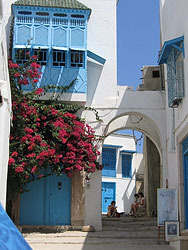
Sidi Bou Said, overlooking the Bay of Tunis, is known for the extensive use of blue and white colors all over the town.
Culture is history—bound—it cannot live without it, it evolves with it. And in the Maghreb, as in the rest of Africa and the Middle East, history repeats itself and constantly shuffles its cards, hoping to avoid past mistakes (both their own and those of the colonizing powers). I had a great opportunity to witness how the desire for freedom and peace is challenged daily, and to see how it is interwoven in the lives of every person. Understanding how the Arab world functions and where it fits in the puzzle of nations is essential. Its construction is often fragile.
During my stay in Tunisia, the war between Israel and Lebanon broke out and the pieces of this very delicate puzzle began scattering about the region. Any attentive Westerner in the Arab world at that moment had the clear opportunity to understand first-hand how past mistakes can easily be repeated with tragic consequences. Lebanon is a small country, a tiny country by geographical measure, yet it is large in its acceptance of diversity: Lebanon makes heroic efforts to blend together its various communities by accepting and respecting each other’s difference. One could not help asking: Couldn’t Lebanon constitute a solution for our divided world? Why did it have to suffer again? The civil war that ended 15 years ago and the ensuing reconstruction was long and thorough and ultimately successful. What was achieved in the recent war? Widespread destruction and promises to help reconstruct. The absurdity of such responses to such hapless events speaks for itself.
My goal at the CEMAT was to better understand French colonization of the Maghreb, and aftermath in that region. I undertook a comparative study of Tunisia and Algeria in their approach to French identity and language as they freed themselves from years of cultural, economic, and political occupation.
Tunisia gained its independence in 1956, while Algeria did so in 1962 after protracted combat between the French army and Algerian resistance and insurrection groups (all quite divided in their approach to a settlement). Habib Bourguiba was the first president of independent Tunisia, his major goal being to maintain secular control over the Tunisian schooling and administrative systems. Thus, Muslim groups had less influence and power in governing the country. Bourguiba also maintained the use of French throughout the school curriculum; the result of this was that after independence Arabic was introduced progressively and had more time to establish itself in the system than it had, for instance, in Algeria.
Algeria’s journey to independence was much more complex and difficult than Tunisia’s. Tunisia had been a protectorate of France, while Algeria was a “department” (the equivalent of a state or province in the North American continent), and at the time of the insurrections calling for independence, a total of one million European colonizers—mainly from France—lived in Algeria with eight millions Algerians. The battle for independence lasted from 1954 to 1962 and was extremely violent, involving as it did so many French “colons,” who considered Algeria their land and had no intention of returning to France. France on the other hand was not eager to repatriate them because of the imbalance it would create in its economy and politics.
The last part of my work took place in Paris where I continued my research on Algerian independence, and the years of political turmoil that continued into the beginning of this century. I refer specifically to the Algerian civil war of the 1990s that lasted nearly the entire decade. The ’90s are an important era in Algerian history. These were years of bloody warfare between Islamist movements on one side and the government and the army (two entities not always in concordance) on the other. The army and the government furnished weapons to a militia in charge of defending the population against the Islamist factions.
President Abdelaziz Bouteflika was elected in 1999. He encouraged an effort to grant amnesty to the armed groups involved in the bloody war if they handed in their weapons. This attempt resulted in the passage of the Civil Law of Harmony by the Parliament in 2000, which was endorsed by a majority of votes in a public referendum. This act led in October 2005 to a new referendum proposing a Chart for Peace and a national reconciliation by offering amnesty to Islamists and exonerating military and security forces. Such documents helped create a way to move forward. They have given the Algerian people hope for peace after immense suffering. The Chart for Peace should help Algerians establish a national identity so long in coming. Although Algeria is one of the richest countries in Africa because of its oil reserves, its people and its economy have yet to benefit from this resource because of the instability of its politics.
I carried out the latter part of my research at the library of the Institut du monde arabe (IMA) in Paris. While at the Institut, I also had the opportunity to attend the Eighth Biennial of Arab Cinema from July 22 to 30. This naturally was an opportunity to see, first-hand, films from the Maghreb as well as from Egypt, the greatest film producer in North Africa. Screenings were followed by discussion with directors, producers, and actors. On my recommendation, the Bernadotte Library is currently ordering many of these films for use by Gustavus students and faculty.
The mission of the IMA is to build bridges between two civilizations who need to know each other better and who, in fact, are eager to deepen their relations. The Institut’s arena of intent is vast: culture in all its aspects, science, knowledge of customs, and large political problems, always approached with an open mind and spirit. And at the core of culture, what could be more interesting than cinema? All Arab countries produce films, and cinema is the most distributed cultural product across frontiers and in all classes of ours societies.
The purpose of this film festival is to offer the French and European public a large panorama of the most recent Arab films, with a constant concern for integrating most of countries involved, to present a cross-section of fiction and documentary films, and to make short films better known. The Biennial’s approach is to promote Arab modernity in all its forms. Cinema is one of its most striking illustrations since it links art and technology, reconciles gravity and playfulness, and calls for multiple interventions and interpretations at all levels of production. Our college community will certainly benefit from all this with some of the festival films acquired by our library with the Bush Foundation grant I received.
I am eagerly looking forward to sharing the results of my research in Tunisia and France with my students and my colleagues. How often do we talk about our scholarly work with our students? Although we think they might not be interested, they actually are. Frequently they do not know what we really do outside the classroom. They need to perceive us as teachers and scholars, educators and researchers, and to see that these are not two separate entities with no correlation. These two aspects of our work at Gustavus Adolphus go hand in hand and do not stand as a divide in our professional lives. Grants such as those from Bush Foundation help us invite our students to experience our research, and inspire them to investigate into new subjects.
From this particular project on the Maghreb and the implications of French colonization on past and present situations in Northwest Africa and Europe, my students acquire historical knowledge and make it relevant to the material (be it a literary text, a chapter on Francophone Africa in their language book for instance) in order to understand it in its actual context. The relevance and usefulness of knowledge and basic understanding of other cultures comes about through an emphasis on daily life and local experiences (e.g., those very experiences I had doing my research). The correct selection of relevant material and information to convey this knowledge is vital, along with the help of films and geographical landmark material gathered during my stay in North Africa and by mapping the region through devices designed in the College’s Culpeper Language Center. Global and theoretical orientations in the classroom are balanced by detail-oriented activities, which give an image of the landscape and its people. Habitat and dress codes as well as religious patterns must be understood so that when they emerge in our Western societies they are not perceived as conflicts or particular issues but as new forms of societal integration in the corridors of a changing world.
At the core of such projects is grappling with cultural issues of past and modern importance: the urgency of globalization in the context of Islam resistance and adaptation to modernity, and the appreciation of such view points and their analysis. I intend to establish an electronic link between Tunisian scholars and their students and my students for an exchange of ideas on projects cultural, historical or literary in nature. All of the above will of course be shared with colleagues.
It is important that our community of teachers and scholars continue to have the opportunity to engage in the world of ideas and actions. Faculty and administrators transform their home campuses when they increase their international awareness by serving as instruments in internationalizing curricula, and by increasing knowledge and student skills. Thus our students will be engaged in tomorrow’s world as curious learners. On U.S. campuses, teaching that is amiable to and inclusive of global perspectives is a vital and necessary response to the rapid pace of globalization. Most importantly, such directions steer us away from ideologically driven views and toward a global view of the world.
Anne-Marie Gronhovd has taught French in the Department of Modern Languages, Literatures, and Cultures since 1988. (Photos of Tunisia by Badie Farah)
